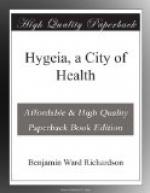Our model city is of course well furnished with baths, swimming baths, Turkish baths, playgrounds, gymnasia, libraries, board schools, fine-art schools, lecture halls, and places of instructive amusement. In every board-school drill forms part of the programme. I need not dwell on these subjects, but must pass to the sanitary officers and offices.
There is in the city one principal sanitary officer, a duly qualified medical man elected by the Municipal Council, whose sole duty it is to watch over the sanitary welfare of the place. Under him, as sanitary officers, are all the medical men who form the poor law medical staff. To him these make their reports on vaccination and every matter of health pertaining to their respective districts; to him every registrar of births and deaths forwards copies of his registration returns; and to his office are sent, by the medical men generally, registered returns of the cases of sickness prevailing in the district. His inspectors likewise make careful returns of all the known prevailing diseases of the lower animals and of plants. To his office are forwarded, for examination and analysis, specimens of foods and drinks suspected to be adulterated, impure, or otherwise unfitted for use. For the conduction of these researches the sanitary superintendent is allowed a competent chemical staff. Thus, under this central supervision, every death, every disease of the living world in the district, and every assumable cause of disease, comes to light and is subjected, if need be, to inquiry.
At a distance from the town are the sanitary works, the sewage pumping works, the water and gas works, the slaughter-houses and the public laboratories. The sewage, which is brought from the town partly by its own flow and partly by pumping apparatus, is conveyed away to well-drained sewage farms belonging to, but at a distance from, the city where it is utilised.
The water supply, derived from a river which flows to the south-west of the city, is unpolluted by sewage or other refuse, is carefully filtered, is tested twice daily, and if found unsatisfactory is supplied through a reserve tank, after it has been made to undergo further purification. It is carried through the city everywhere by iron pipes. Leaden pipes are forbidden. In the sanitary establishment are disinfecting rooms, a mortuary, and ambulances for the conveyance of persons suffering from contagious disease. These are at all times open to the use of the public, subject to the few and simple rules of the management.
The gas, like the water, is submitted to regular analysis by the staff of the sanitary officer, and any fault which may be detected, and which indicates a departure from the standard of purity framed by the Municipal Council, is immediately remedied, both gas and water being exclusively under the control of the local authority.
The inspectors of the sanitary officer have under them a body of scavengers. These, each day, in the early morning, pass through the various districts allotted to them, and remove all refuse in closed vans. Every portion of manure from stables, streets, and yards is in this way removed daily, and transported to the city farms for utilisation.




